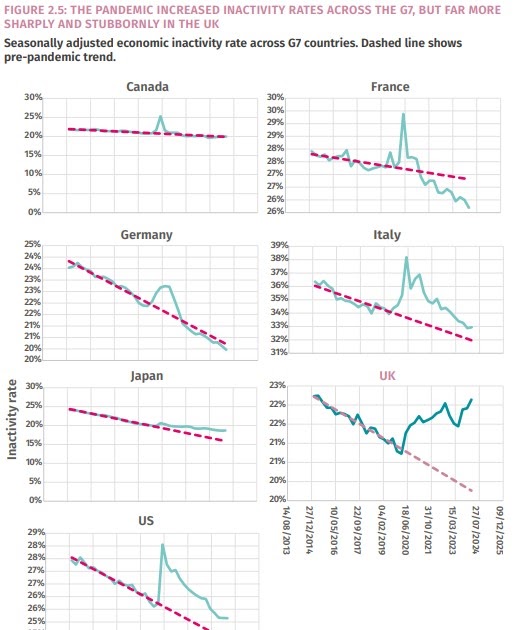Last week the IPPR’s
Commission on Health and Prosperity published its
final report. The report not only makes a number of
important recommendations for future health policy, but it also
focuses on how better health can also improve economic outcomes. I
must admit, when I was first asked to be a member of that Commission,
I did have a minor concern about this. I felt that the argument for
better health was strong enough on its own and it didn’t need an
additional economic payoff as part of its justification.
That may surprise
you coming from an economist, but it is actually a basic part of
academic economics. Academic economists typically write papers where
the aim is to increase individual and social utility, not economic
growth. As countless studies have shown, a person’s health is a key
element of their happiness, wellbeing and therefore utility. [1] But
I also understood that power in the UK lies in the Treasury, so
making the links between better health and a more productive economy
are important.
However, what I
didn’t know when the Commission was being set up was just how
crucial the interactions between health and the economy would become
for the UK in the years after Covid. Here is a chart from the report:
The pandemic led to
a rise in economic inactivity (those in the potential workforce not
working) in many countries, but that rise was partially or completely
reversed once the pandemic was over in nearly every country. The
exception is the UK, where what had been a downward trend in
inactivity became an upward trend. The report estimates that since
the pandemic just under a million workers have left the labour force
in the UK due to sickness (page 20 of the report). This is a huge
number, and impacts on the prosperity of everyone in the UK.
Why has this
happened in the UK and not elsewhere? The report debunks the idea
that it is a ‘lifestyle choice’, by showing that the increase in
inactivity is most marked among those with greater health needs or at
greater health risk. My own guess would be that this is yet another
consequence of the squeeze in resources going to health in the UK
since 2010. The NHS was just about managing even though it was
working beyond full capacity, but this meant that the UK health
system was particularly vulnerable to a big health shock, and as
waiting time data shows it has yet to show any signs of recovery from
the shock of the pandemic.
The rise in those
with long term health conditions doesn’t just lead to exits from
employment, but also lower earnings (page 17) and productivity (page
26) for those who remain. Once again, the latter in particular has
knock on effects on everyone else in the UK. For those who worry
about this it also puts upward pressure on immigration. If I had to
give two ways I was confident about how we could improve the UK’s
growth and productivity performance, it would be through additional
public investment and through improving UK health.
Most of the report
is about how to do the latter, during a period when the government is
likely to believe that money is very tight. The key emphasis is on
moving away from a health mission all about dealing with acute need
(what the report calls the ‘sickness model’, page 35), and
instead aiming to create good health (page 39). In the sickness model
personal health is seen largely as an individual responsibility, and
society only gets involved when health problems arise. The problem
with that model is nicely summarised by this graphic from the report:
Social conditions
help determine how much people are able to take care of their health,
and with a few exceptions we have largely ignored this problem.
Focusing on the eventual effects of these social conditions rather
than the conditions themselves not only reduces social welfare, but
it is also more costly. Rising levels of obesity is an obvious
example of this.
The idea that we
should focus on prevention rather than cure is not new. What the
report does very well is systematically and broadly think about what
prevention might involve. It involves improving workplaces, for
example, by incentivising firms to reduce stress and improve the
workplace culture (page 41). It involves improving the unusually low
level of UK sick pay which will help avoid sick people coming to
work, taking longer to recover and affecting other workers. It
involves taxing unhealthy goods far more than we do at present, and
using some of that money to subsidise healthy goods (page 43). It
involves providing more help and care for our children outside school
(45). It involves reducing inequalities. And of course it involves
reorienting more NHS expenditure towards health monitoring rather
than treating illness.
For those who say
this all sounds like creating a nanny state, let me introduce you to
the basic economic idea of a Pigouvian tax. Sometimes individuals do
things that have negative effects on others, but society rather than
the individual bears the cost of those things. (We are used to
thinking about negative externalities in the context of firms and
issues like pollution, but the idea is far more general than that.) A
Pigouvain tax tries to shift the cost from society back on to the
individual. This leads to better social outcomes, and it also raises
much needed cash.
Sometimes this idea
can be applied directly, and a sugar
tax is a very good example. In other situations
applying a tax is not possible, so other incentives or regulations
need to be employed. To go into all the ideas proposed by the report
would make this post far too long, so I strongly recommend reading
the report itself (page 53 onwards). It is full of ideas, case
studies and international comparisons.
One final point.
There are so many reports around nowadays, many of which have worthy
goals but which involve additional costs to the public sector that
are often left vague. This report includes an appendix which presents
a costing of each proposal, or in some cases how much money a
proposal will raise. If you take all the reports proposals together there is of course an immediate net fiscal cost,
but like public investment this is not only money well spent, but is
likely to pay for itself because of the benefits to the economy that
will result.
[1] The relationship
between happiness, wellbeing and utility is both interesting and
complex, but that is for another time.




